Introduction: Ghost vs Medium in 2025 - the 60‑second answer
Who this guide is for
Independent writers, creators, and small teams choosing a primary home for their writing
SaaS founders/marketers weighing owned blogs vs. platform reach
TL;DR
Pick Ghost for ownership, branding, SEO control, and recurring revenue via memberships/newsletters
Pick Medium for zero setup, built‑in distribution, and a social reading experience
Many writers use both: own your site on Ghost, syndicate to Medium for reach
If you’re a SaaS team that wants SEO growth with near‑zero manual work, consider an automation‑first alternative (see BlogBowl notes throughout)
What you’ll get in this comparison
A quick at‑a‑glance table
Clear pros/cons, pricing/monetization, writing experience, audience growth, SEO/analytics, setup/migration
Final recommendations by use case
Feature | Ghost | Medium |
|---|---|---|
Editor | Clean, block-based (powerful formatting, embeds) | Minimal, distraction-free social editor |
Ownership | Full ownership of content and audience | You own content; platform controls access and feed |
Domain/Branding | Custom domain, themes, full branding control | No custom domain; uniform Medium look and feel |
Distribution | Depend on SEO, email, and your channels | Built-in network effects and topic distribution |
SEO Control | Granular SEO settings, schema control, technical flexibility | Limited meta control; platform handles most SEO |
Monetization Model | Native memberships/newsletters; keep revenue | Partner Program; platform-managed paywall |
Analytics | Native + third-party integrations, deep insights | Basic platform analytics tied to Medium ecosystem |
Extensibility | Open ecosystem, APIs, custom themes/integrations | Closed ecosystem; limited customization options |
Pricing and monetization: what you actually keep vs. what you trade off
Ghost
Business model: software subscription (Ghost(Pro)) or self‑host; 0% platform fee on creator revenue (Stripe fees apply)
Built‑in memberships, paywalls, and newsletters; full control of pricing/tiers
Flexible monetization: sponsorships, ads, affiliates, products, services
Medium
Free to publish; requires active membership to join/earn in the Partner Program
Revenue model based on member reading time and engagement; limited control over pricing
External monetization via links allowed with constraints
What matters for writers
Predictability of revenue and control of pricing (Ghost) vs. ease of earning inside a closed ecosystem (Medium)
Owning subscriber list and payment rails (Ghost) vs. platform‑dependent payouts (Medium)
Pro tip
Many creators use Ghost to own recurring revenue and email list, then cross‑post to Medium for discovery
Category | Ghost | Medium |
|---|---|---|
Platform fees | Subscription for hosting; 0% fee on creator revenue (payment processor fees apply) | Free to publish; earnings tied to Partner Program terms |
Revenue control | Full control over pricing, tiers, bundles | Limited; cannot set membership price for platform paywall |
Memberships | Native memberships and paywalls built in | No creator‑controlled tiers; platform paywall governs access |
Ads/Affiliates | Allowed: ads, sponsorships, affiliates, products/services | External monetization allowed with policy constraints |
Email ownership | You own subscriber emails and can export/migrate | Followers/subscribers are platform‑bound; emails not portable |
Payout mechanics | Direct payouts via Stripe; predictable recurring revenue | Monthly payouts based on member reading time; variable/algorithmic |
"As of 2025, the average email open rate across all industries is approximately 42.35%." - Source
Writing and editor experience: Koenig vs. Medium’s minimalist editor
Ghost (Koenig editor)
Clean, distraction‑free writing with rich cards/blocks (embeds, galleries, CTA, code, HTML)
Built‑in newsletter formatting; markdown support; custom themes affect reading experience
Excellent for long‑form, editorial design, and content hubs
Medium
One of the best minimalist editors for fast drafting
Seamless embeds; consistent typography and layout - no design decisions needed
Great for writers who want to write without setup or formatting choices
Bottom line
Ghost maximizes flexibility and pairing content with your brand; Medium maximizes speed and simplicity
Ownership, branding, and licensing: who controls your content and audience?
Ghost
Your domain, your design, your data; export anytime
Fully custom themes; total brand control across pages, posts, and emails
Medium
Publishes under Medium’s design language; limited brand control
Broad content license typical of social platforms; payout/visibility subject to policy changes
Why this matters
Portability and long‑term asset value (SEO equity, email list, links) favor Ghost
Convenience and network effects favor Medium
Practical tip
Own your primary content and email list on an independent domain; syndicate to platforms for distribution
"You retain ownership of your content, but grant Medium a non‑exclusive, royalty‑free, worldwide, fully paid, and sublicensable license to use, reproduce, modify, adapt, publish, translate, create derivative works from, distribute, publicly perform and display your content in all media formats and distribution methods now known or later developed on the Services." - Source
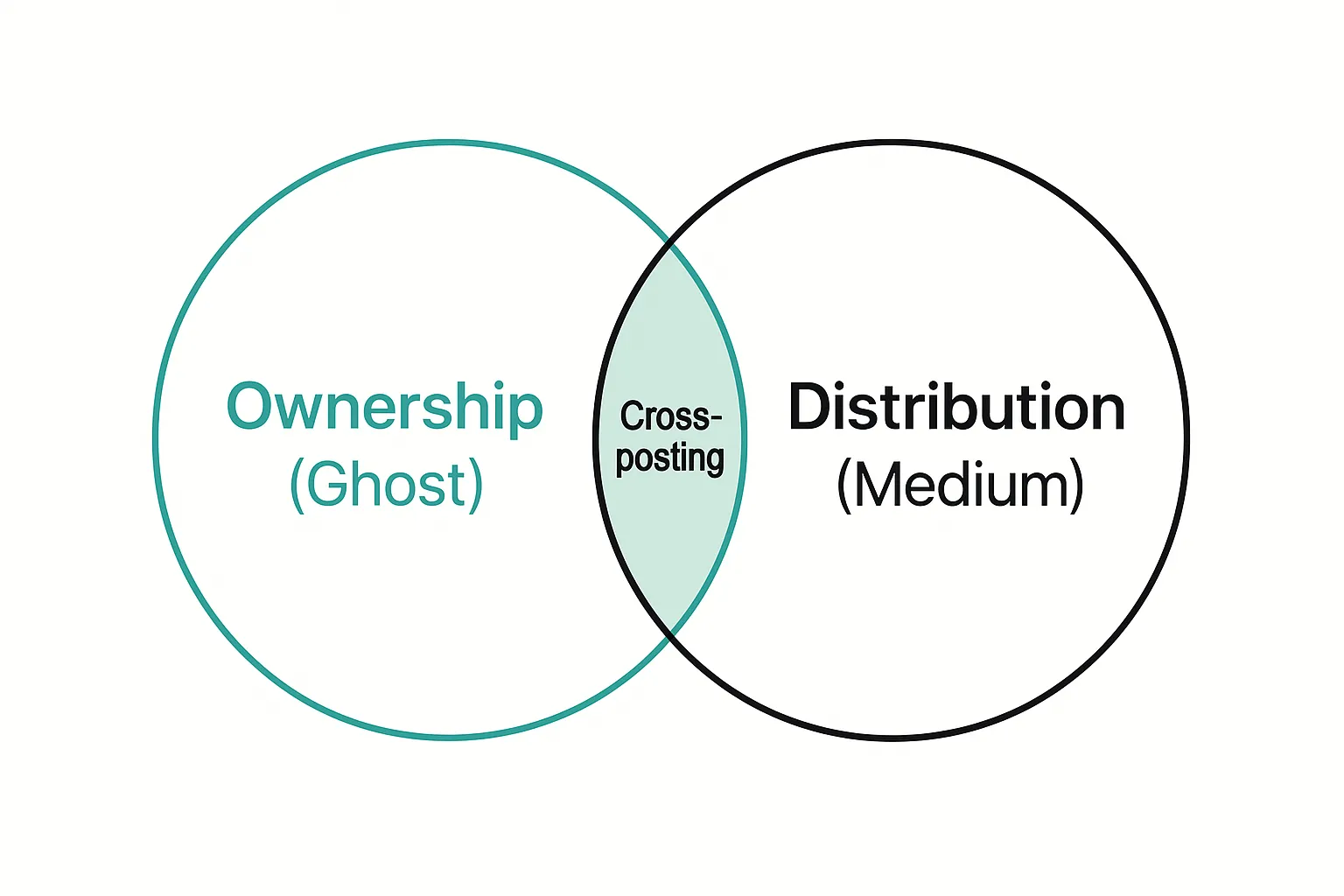
Audience growth and distribution: platform network vs. owned channels
Medium
Built‑in reader network, curation, publications, tagging, and recommendation engine
Easiest path to early traction without a pre‑existing audience
Ghost
Grow via SEO + newsletters + social; use memberships to deepen engagement
Full access to subscriber list for lifetime audience portability
Smart growth play
Publish on Ghost; cross‑post best pieces to Medium with canonical tags; invite Medium readers back to your owned newsletter
Reality check
Platform algorithms change; owned audience (email + domain) is durable
"Medium reaches ~100M monthly readers, offering powerful discovery potential for new writers." - Source
SEO, analytics, and performance: ranking, insights, and site speed
Ghost
Full control of meta titles/descriptions, structured data via themes, and image alt text
Easy integration with Google Analytics/Search Console; privacy‑friendly built‑in analytics
Fast, lightweight themes; control over performance budgets and CDNs
Medium
Strong on-page defaults and image optimization, but limited SEO configuration
Platform analytics only; no Search Console/GA for your namespace
Practical setup
On Ghost: connect GSC + GA, map keywords to topics, build internal linking and topic clusters
On Medium: use publications/tags, link back to owned site/newsletter, leverage canonical tags when cross‑posting
BlogBowl note
If you want SEO content creation, internal linking, and publishing automated for a business blog, consider an automation‑first platform like BlogBowl alongside (or instead of) Ghost/Medium
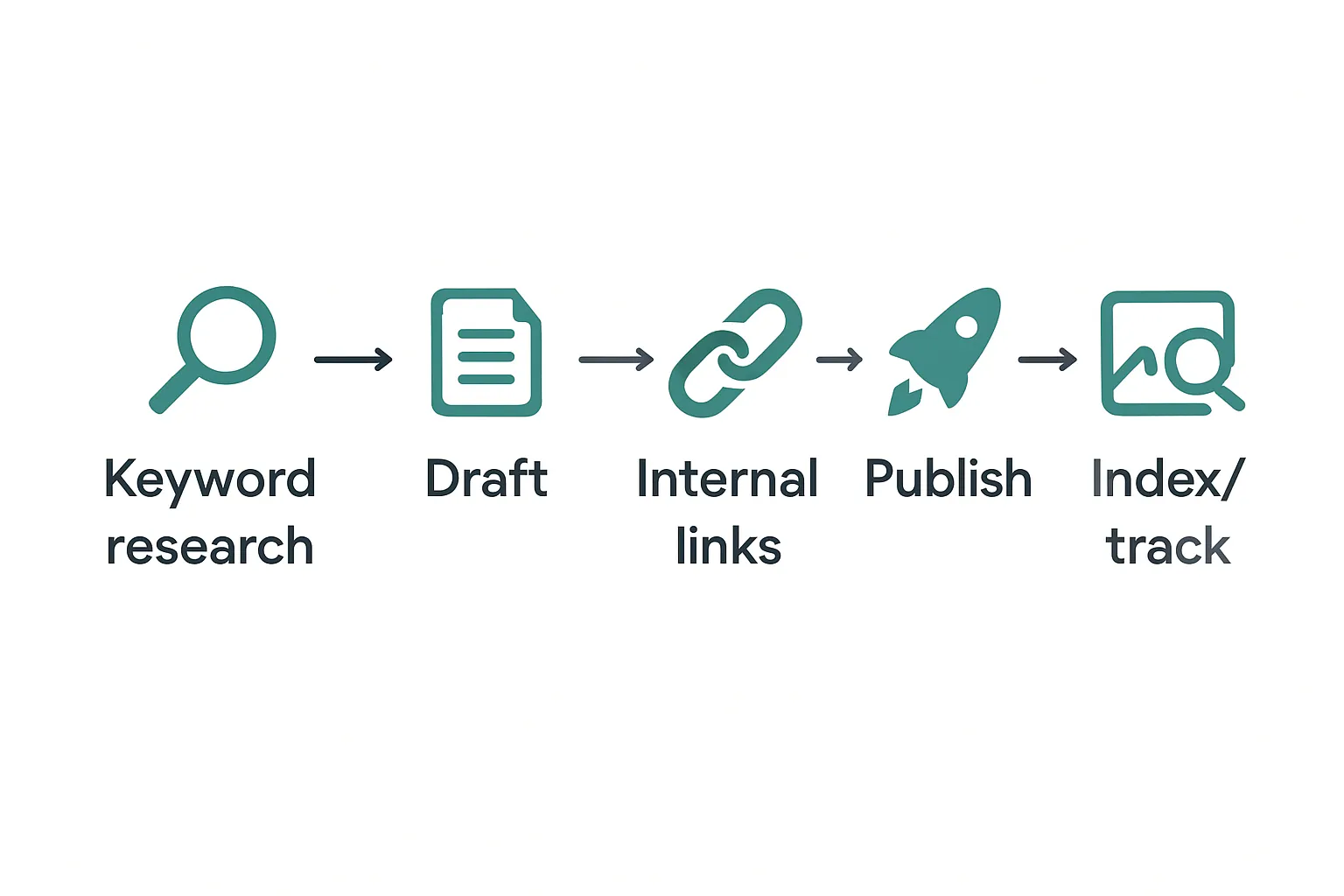
Setup, migration, and extensibility: from first post to full stack
Getting started
Medium: create account → write → publish (minutes)
Ghost: spin up Ghost(Pro) or self‑host → connect domain → pick theme → publish (minutes to hours)
Migration
Medium → Ghost: export stories; import to Ghost; set up redirects/canonicals; move email list
Keep Medium as a distribution channel post‑migration
Extensibility
Ghost: themes, routes, custom templates, webhooks, and robust API; integrates broadly
Medium: limited customization; extensions mainly via embeds and referral links
Screenshots
Show main homepages so readers recognize each platform quickly
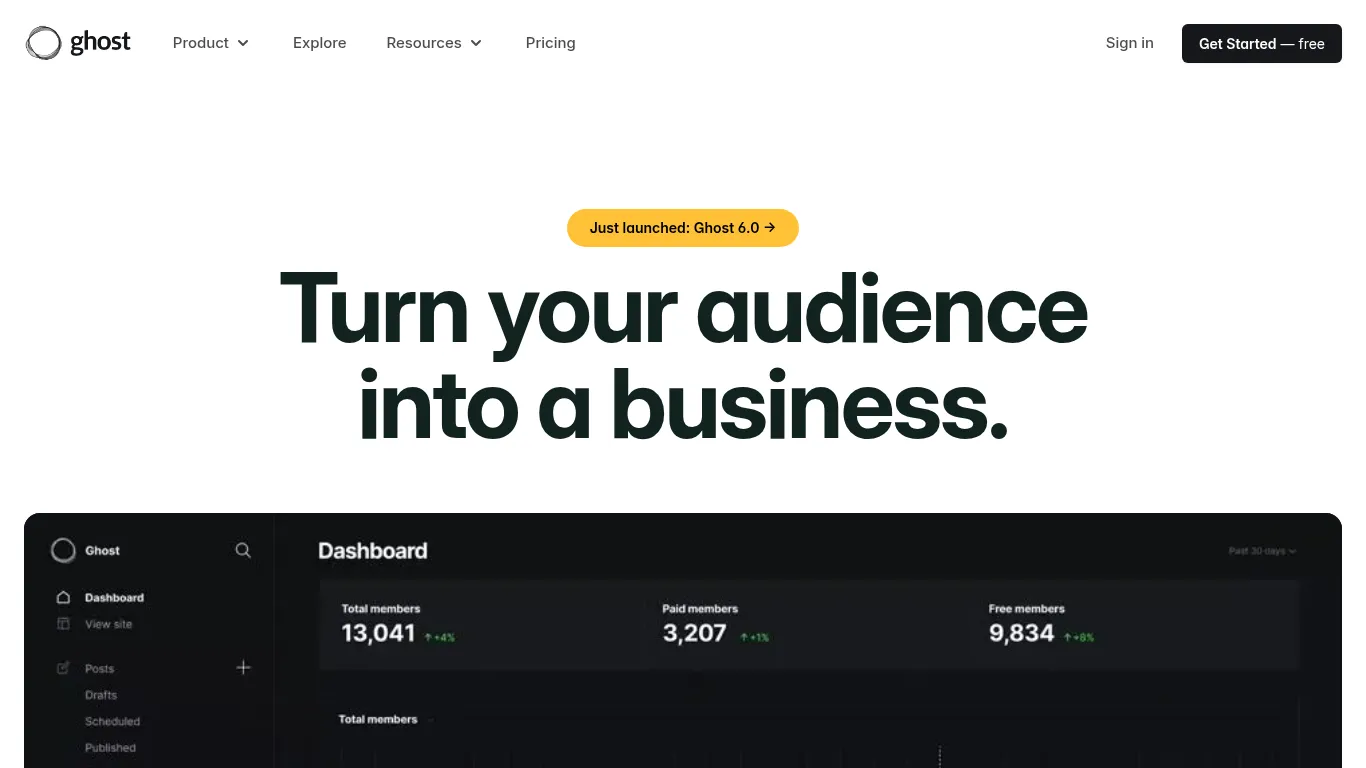
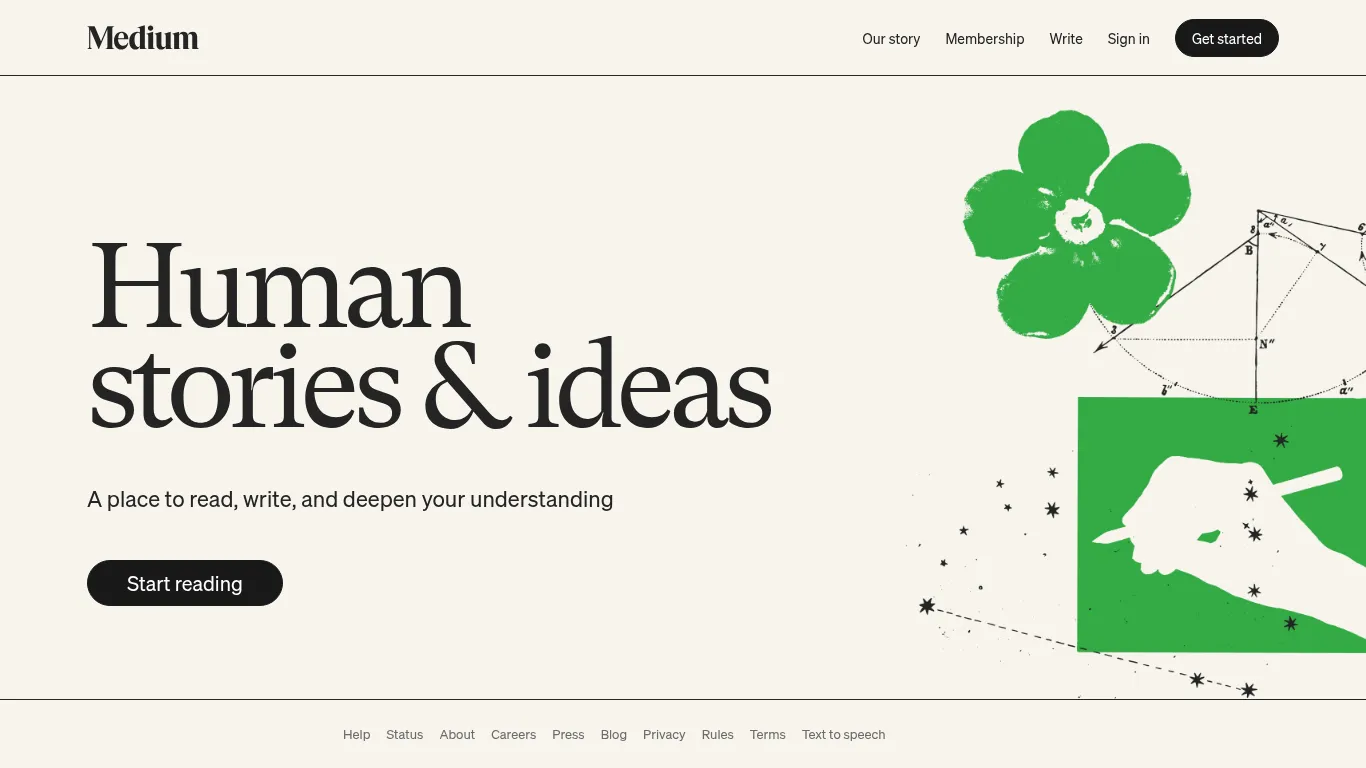
Support, community, and long‑term viability
Ghost
Open-source core and sustainable, product‑focused roadmap
Active theme/integration ecosystem; transparent development cadence
Strong contributor community and documentation; easy to export everything (content, members, themes)
Medium
Stable platform for readers; product direction optimized for network health and member value
Policy/visibility rules can shift; creators should hedge by owning an email list
Little control over roadmap; exports are possible but audience portability is limited
What to consider long‑term
Can you export everything you need?
Do you control revenue channels and reader relationships?
Will your content’s design and structure remain under your control?
If platform policies change, can you maintain reach and income?
Is there a path to scale beyond “just publishing” (memberships, data, integrations)?
Use‑case playbook: pick your path in under a minute
If you’re a solo writer starting from zero
Choose Medium for immediate reach; start collecting emails to an owned list
When you see traction, stand up a Ghost site as your home base
If you’re building a membership business or premium newsletter
Choose Ghost to own pricing, tiers, and audience; optionally syndicate to Medium
If you run a SaaS or startup blog
Choose Ghost or an automation‑first platform (e.g., BlogBowl) for SEO, speed, and control; share select thought leadership on Medium for reach
If you want zero setup forever
Choose Medium and accept design/licensing trade‑offs
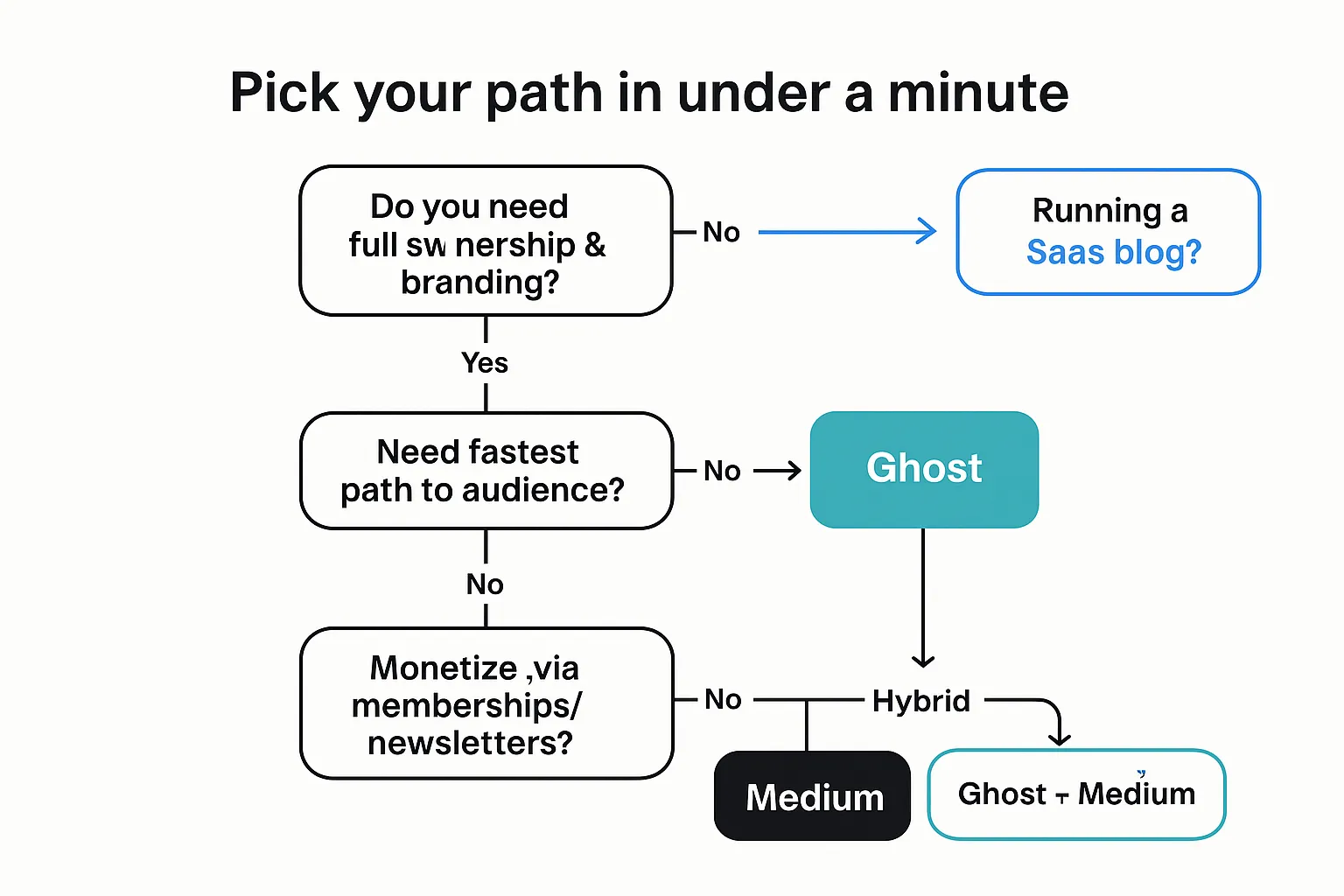
Final verdict: Which one should you choose? (+ a hybrid plan that works)
Choose Ghost if
You want long‑term asset compounding (SEO + email) on your domain
You need full control over branding, pricing, and monetization
You plan to build a publication or membership business
Choose Medium if
You value instant setup and built‑in discovery over control
You prefer writing only, with minimal site/admin responsibilities
The hybrid plan (recommended for many)
Own your site and list on Ghost; cross‑post high‑performers to Medium with canonical tags; invite readers to subscribe to your owned newsletter
Where BlogBowl fits
If you’re a SaaS/startup team that wants hands‑off SEO content, daily posts, internal linking, built‑in analytics/newsletters, and fast templates, consider BlogBowl as your primary blog engine; you can still syndicate essays to Medium for reach
In short: Ghost maximizes ownership and monetization, Medium maximizes speed to audience, and a Ghost+Medium hybrid gives you the best of both. For SaaS teams, BlogBowl adds automation so you grow faster with less effort.


